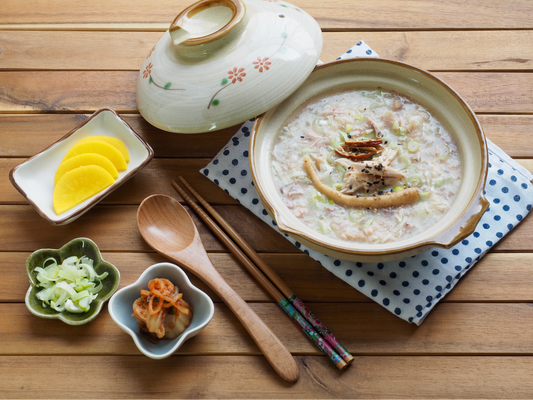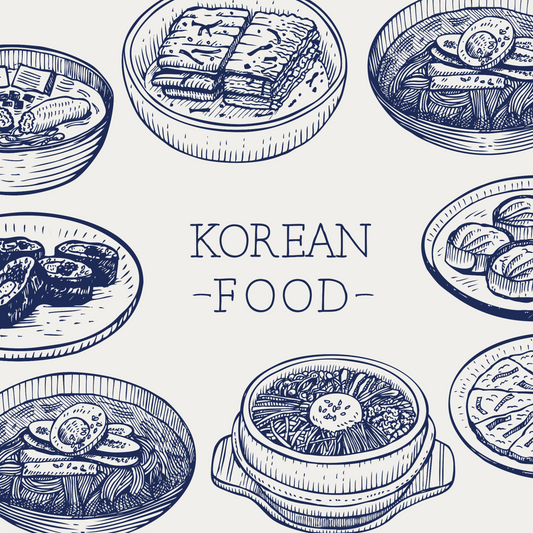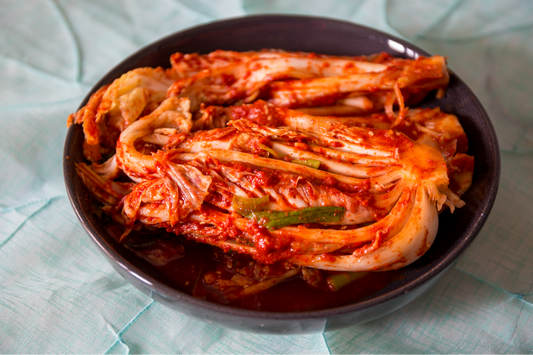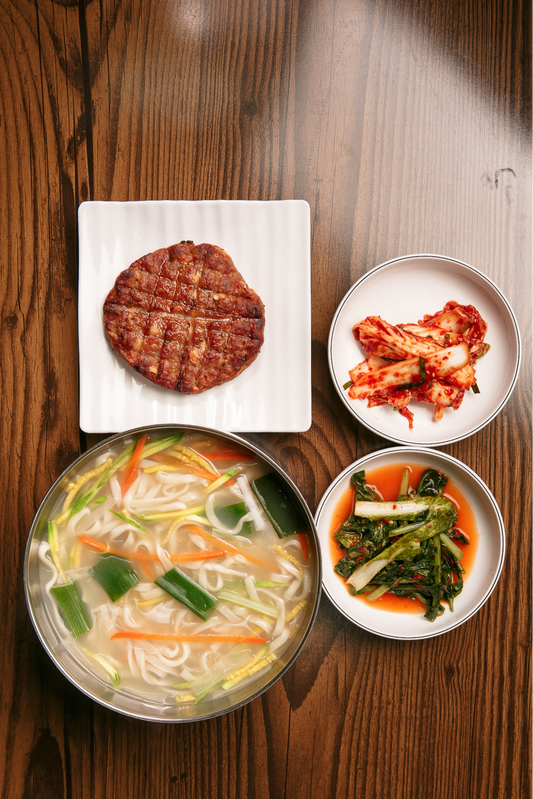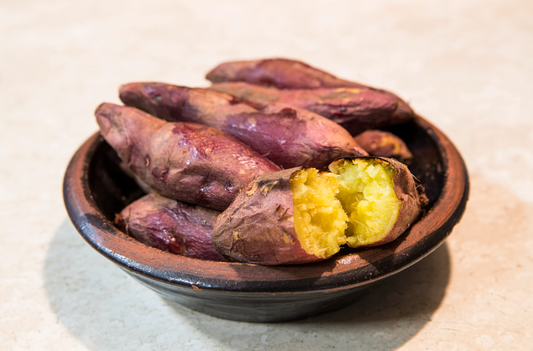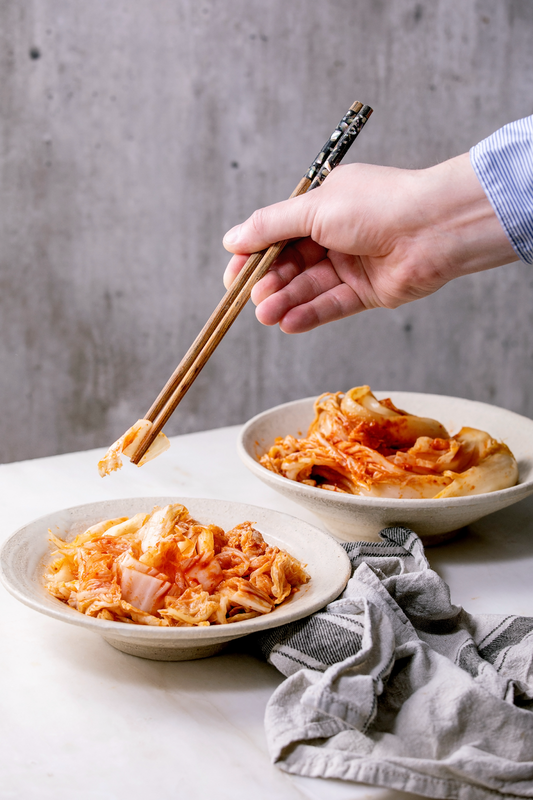From Kimchi Tuna Rice Bowl to Aged Kimchi Braised Chicken: Recipes Balancing Spice and Tenderness

Ever wonder how a dish is both spicy and tender? Discover the secret with an aged kimchi braised chicken recipe. Learn how to make kimchi tuna rice bowl. Both dishes are traditional Korean dishes that wow your taste buds and offer a cozy feeling. They're linked to the culture and history of Korean food. Dive into fermented kimchi dishes and expand your kitchen skills with valuable kimchi cooking tips. Enjoy the deep flavors and heritage in every bite.
Key Takeaways
-
Master the complexity of preparing fermented kimchi dishes with step-by-step guidance.
-
Explore the cultural richness and flavors of traditional Korean dishes for your home cooking.
-
Discover the balance of heat and texture in an aged kimchi braised chicken recipe.
-
Learn how to make kimchi tuna rice bowl that merges freshness with a spicy kick.
-
Benefit from practical kimchi cooking tips to elevate your culinary skill set.
-
Understand the use of ingredients like fresh pork belly, gochugaru, and tofu in Korean cooking.
-
Utilize sour kimchi to its full potential in a variety of delicious and traditional recipes.
Mukeunji Dakbokkeumtang Recipe
Jump into the rich tastes of Mukeunji Dakbokkeumtang. This traditional Korean stew mixes aged kimchi with tender chicken. The aged kimchi, called mukeunji, is at least six months old. It gives the dish a deep flavor that showcases Korea's culinary history.
Ingredients and Cooking Method for Mukeunji Dakbokkeumtang
This recipe needs chicken thighs or drumsticks, and aged kimchi. You'll also need gochujang (Korean chili paste), onions, potatoes, and carrots. Marinate the chicken with soy sauce, minced garlic, and gochujang first.
Then, in a large pot, add the marinated chicken, kimchi, onions, and potatoes. Cook until the chicken is tender and the veggies soak up the flavorful broth. To balance the sour and spicy taste of kimchi, add a bit of sugar. It makes the stew flavors blend well.
Estimated Cooking Time for Mukeunji Dakbokkeumtang
Cooking this tasty stew takes about 45 minutes to 1 hour. If you use an Instant Pot, you can cook it faster while keeping the flavors strong. This makes Mukeunji Dakbokkeumtang great for quick dinners or to impress guests without much effort.
Difficulty Level of Mukeunji Dakbokkeumtang Recipe
Making this dish is straightforward, so most cooks can try it. The main challenge is blending the flavors well. This requires patience and watching the dish as it cooks. With these spicy braised chicken tips, even beginners can make a great aged kimchi dish.
If you love cooking or are new to Korean food, try Mukeunji Dakbokkeumtang. It offers a lovely taste of Korean home cooking. Follow these steps and enjoy the wonderful smells and flavors in your kitchen.
Mukeunji Dakbokkeumtang Cooking Tips
Starting your Mukeunji Dakbokkeumtang journey can be fun and exciting. The blend of harmony of tuna and kimchi is crucial. Learning cooking tricks can turn your meal into a comforting experience that feels like a warm hug from Korean cuisine.
Secrets to Achieving Tender Chicken with Spicy Aged Kimchi
Choosing the right chicken parts is key for a moist, tender result. Go for thighs, drumsticks, and wings. They keep moisture and add deep, real flavors that are vital for that rich taste. Start by parboiling these pieces. This reduces cook time and lets the chicken soak up the spicy aged kimchi better. Parboiling is a smart move for getting that melting texture that combines well with the strong taste of the kimchi.
Tips for Balancing Spiciness and Depth of Flavor in Mukeunji Dakbokkeumtang
Controlling the spice while keeping a full flavor needs careful seasoning. Begin with a soft hit of gochujang. Then add gochugaru to taste, increasing heat gradually. If you're not big on hot flavors, cut the gochugaru in half. Add flavors bit by bit to keep it from being too spicy. This way, every spoonful is spicy yet full of the savory and sour notes of aged kimchi dishes.
Also, don't forget about using a good stock. It's the base that brings all tastes together. A solid broth makes the chicken softer and boosts the mature kimchi flavors. This creates a perfect symphony of tastes. Follow these tips, and your Mukeunji Dakbokkeumtang will feed your body and comfort your soul with every bite.
Mukeunji Dakbokkeumtang Variations and Applications
Mukeunji Dakbokkeumtang is a traditional Korean dish known for its deep flavors. It mainly includes chicken and aged kimchi. Yet, you can swap the chicken for tofu or beef. This lets everyone enjoy it, according to what they prefer. It's perfect for tweaking to suit your taste in spicy dish recipes.
Creative Variations of Mukeunji Dakbokkeumtang
Adding different veggies can improve the dish's texture and nutrition. Mushrooms and Korean radish are popular choices. Mushrooms soak up the spicy sauce, and radish adds crunch. If too much spice isn't your thing, you can use less gochugaru or a milder pepper. This keeps the flavor rich but not too hot. Mukeunji Dakbokkeumtang is versatile enough to be loved in many ways. It's a beloved part of traditional Korean dishes and spicy dish recipes.
Health Benefits of Main Ingredients in Mukeunji Dakbokkeumtang
Mukeunji Dakbokkeumtang is a traditional Korean stew that is not just tasty. Its main ingredients, aged kimchi and chicken, are key to its health benefits. Aged kimchi is known for its role in boosting digestive health. This is due to the probiotics that help our gut flora.
Health Benefits of Aged Kimchi and Chicken in Mukeunji Dakbokkeumtang
Aged kimchi shines in this dish, not just by enhancing its taste but also health benefits. Through fermentation, vitamins become more available and beneficial bacteria grow. This process helps with digestion and may boost the immune system. Kimchi is also low in calories but high in fibers, vitamins A and C, and minerals like iron and calcium.
Chicken adds high-quality protein to Mukeunji Dakbokkeumtang, which is vital for muscles. It’s also packed with B vitamins, aiding in energy production and brain health. Together, chicken and kimchi make this dish both nutritious and supportive of muscular and digestive health.
Eating Mukeunji Dakbokkeumtang is both a joy and a step towards better health. It’s a dish that brings together all the goodness of aged kimchi in every bite.
Taste and Aroma of Mukeunji Dakbokkeumtang
The taste and smell of Mukeunji Dakbokkeumtang show how rich Korean food is. Each bite and sniff take you through a story filled with tradition and detail. As soon as it cooks, the smell spreads, inviting you to taste its heritage.
Unique Flavor and Aroma of Mukeunji Dakbokkeumtang
Mukeunji Dakbokkeumtang gets its unique taste by aging kimchi. This makes the stew taste deeper and richer. It combines well-seasoned chicken with the deep taste of kimchi. Then, gochujang and gochugaru add a spicy touch, making it a favorite spicy chicken dish in Korea.
While cooking, a sweet and spicy aroma fills the air. This makes waiting for the dish an enjoyable part of the meal. It's a warm and cozy dish, great for everyone looking for true Korean tastes that are vibrant and soothing.
Mukeunji Dakbokkeumtang perfectly mixes savory, spicy, and sweet. It's more than just food—it's an invite to come together and enjoy the deep flavors and smells. It truly stands out in Korean cuisine as a delicious and meaningful experience.

Recommended Side Dishes and Drinks for Mukeunji Dakbokkeumtang
When serving Mukeunji Dakbokkeumtang, a top traditional Korean dish, pairing it right is key. Steamed white rice is always a hit, with its smooth texture and gentle flavor. It goes great with the stew's bold, spicy sauce.
This match highlights the rich flavors from seasoned, fermented kimchi, vital for kimchi cooking tips.
Perfect Side Dishes and Beverages to Pair with Mukeunji Dakbokkeumtang
Ramen noodles can soak up the stew's spicy sauce, offering an amazing taste. Or, tteokbokki rice cakes add a chewy feel, contrasting well with tender chicken. There's also Vietnamese Garlic Noodles for a garlicky, strong flavor that matches the stew's spice.
A light, crisp Korean barley tea is great for cleansing your palate. If you prefer cold drinks, a chilled lager works great. It cuts through the spice, adding a refreshing touch without hiding the meal's taste.
Choosing the right sides and drinks makes enjoying Mukeunji Dakbokkeumtang even better. Always aim for balance between the main dish and accompaniments, for a true Korean cuisine experience. Keep the kimchi cooking tips in mind for perfect harmony.
Kimchi Chamchi Deopbap Recipe
Start a food adventure with Kimchi Chamchi Deopbap. It's a special dish blending kimchi and tuna. It's perfect for those wanting a quick yet tasty meal. This recipe fits fast-paced lives and explodes with flavors that please everyone.
Ingredients and Cooking Method for Kimchi Chamchi Deopbap
Want to make your own Kimchi Tuna Rice Bowl? You'll need 1.5 cups of cooked short-grain rice, ⅓ cup chopped kimchi, 5.29 oz canned tuna, and 4 tablespoons of mayonnaise (Japanese or regular). Don't forget teriyaki sauce, salt, and pepper for seasoning. First, cook eggs in oil, then add rice, kimchi, and tuna. End by mixing in mayonnaise and teriyaki sauce for a creamy taste.
Estimated Cooking Time for Kimchi Chamchi Deopbap
This dish is simple and quick to make. With pre-cooked rice, assembling your how to make kimchi tuna rice bowl only takes about 10 minutes. It's perfect for a busy night or a quick lunch.
Difficulty Level of Kimchi Chamchi Deopbap Recipe
This recipe is great for beginners or anyone new to Korean cooking. It's easy to make, yet still allows for creativity. Even experienced cooks can add their unique touch.
Kimchi Chamchi Deopbap is nutritious and packed with flavor. It's a versatile meal for any time. Try it to experience Korean cuisine's depth, with kimchi and tuna's unique flavors coming together beautifully.
Kimchi Chamchi Deopbap Cooking Tips
Making harmony of tuna and kimchi in kimchi chamchi deopbap starts with the best ingredients. Choose aged kimchi for a deep flavor that complements tuna. Pick Korean canned tuna for its great taste and quality. Brands like DongWon add authenticity to your dish.
Tips for Perfectly Pairing Kimchi and Tuna in a Rice Bowl
To make your dish harmonious, mix kimchi and tuna with thought. Use aged kimchi for its strong flavor. A bit of kimchi juice blends the flavors well, adding a nice tang. A little sesame oil will smooth out the tastes, finishing off the dish nicely.
Secrets to Balancing Flavors in Kimchi Chamchi Deopbap
The secret to great tuna and kimchi flavor is in how you season and cook. Fry the tuna gently to contrast with the spicy kimchi. Season the rice with a little vinegar and sugar to balance the flavors. Top with green onions or sesame seeds for a fresh finish.
Kimchi Chamchi Deopbap Variations and Applications
Fermented kimchi dishes offer a wide range for creativity, especially with Kimchi Chamchi Deopbap. This dish is lively with flavors. It welcomes many changes that suit your taste or needs. And it still keeps its unique kimchi taste.
Different Styles and Variations of Kimchi Chamchi Deopbap
The base of this dish is usually canned tuna, known for its protein and omega-3s. But you can try other things. You might use salmon, chicken, or soft tofu stew variations for a veggie version. Each option brings a new taste and texture to the dish.
You can also choose different kinds of rice. Instead of the usual sushi or jasmine rice, try brown or Korean Purple Rice. These choices are healthier and add a nutty flavor. If you want something new, mix in a salad with lettuce and cucumber. Then, top it with spicy kimchi and your choice of protein. This makes a fresh and filling meal for any time.
Adding various veggies and sauces lets you make the dish your own. Use Japanese Kewpie mayonnaise or make a sweet eel sauce. Adding sesame oil adds even more taste. Top it off with green onions, toasted sesame seeds, or furikake for looks and flavor.
The key to fermented kimchi dishes like this is creativity. You can play with the spice by using different kimchis. Or make it richer with avocados and eggs. Kimchi Chamchi Deopbap is a dish that loves new ideas while honoring Korean tastes.
Health Benefits of Main Ingredients in Kimchi Chamchi Deopbap
Kimchi Chamchi Deopbap combines Korean flavors and nutrition. It has two main ingredients: kimchi and tuna. Both are great for health.
Health Benefits of Kimchi and Tuna in Kimchi Chamchi Deopbap
Kimchi, a famous fermented kimchi dish, is known for its flavor and health benefits of kimchi. It is full of vitamins A, B, and C. Kimchi also has a lot of fiber, which is good for your stomach. Plus, it has antioxidants and probiotics that help your immune system.
These probiotics make your gut healthier, which is important for digestion and overall health. The fermentation process makes kimchi even better for your gut.
Then there's tuna, which is packed with protein and known for its omega-3 fats. These fats help keep your heart healthy, lower inflammation, and help your brain work better. Adding tuna to Kimchi Chamchi Deopbap makes the dish more flavorful and heart-healthy.
Kimchi and tuna together create a tasty and nutritious dish. Kimchi Chamchi Deopbap is a wise choice for anyone focusing on their health. It offers great health benefits while being delicious with every bite.

Taste and Aroma of Kimchi Chamchi Deopbap
The dish Kimchi Chamchi Deopbap blends aged kimchi's tang with tuna's subtle taste. This mix pleases the palate and releases a fragrant bouquet. This bouquet has potent, pleasant tones that fill the kitchen. Aged kimchi adds savory depth, making the tuna's taste fresher. This is very clear in Korean canned tuna, spiced with hot pepper or kimchi.
Distinctive Flavor Profile and Aroma of Kimchi Chamchi Deopbap
The dish's flavors stand out, especially the harmony of tuna and kimchi. Fermented kimchi's sharpness contrasts with tuna's rich taste. Each spoonful brings a burst of flavor and texture. The creamy mayonnaise and crisp onions add to this experience.
Fans of aged kimchi braised chicken recipe will notice similar smells in Kimchi Chamchi Deopbap. Kimchi's fermentation releases a strong aroma. Combined with tuna, it creates a robust, inviting dish. This dish promises a meal full of Korean culinary tradition.
Kimchi Chamchi Deopbap is more than a taste journey. It awakens all senses, showcasing Korea's culinary heritage. Each serving is an intimate experience of Korea's cherished tastes. It brings together aged kimchi and tender tuna harmoniously.
Recommended Side Dishes and Drinks for Kimchi Chamchi Deopbap
To fully enjoy Kimchi Chamchi Deopbap, it's key to pick the right sides and drinks. This traditional Korean dish is spicy and full of flavor. The right partners can make each bite more enjoyable.
Ideal Side Dishes to Complement Kimchi Chamchi Deopbap
If you need tips for cooking with kimchi, pick the right side dishes. Try light salads or steamed veggies, like spinach or bok choy. They add a fresh touch to the dish's spice and umami.
For a true Korean meal, think about kimchi pancakes or mandu (Korean dumplings). They match the taste of kimchi and add a nice texture. These sides make the meal complete without overpowering the main dish’s flavors.
Recommended Beverages to Pair with Kimchi Chamchi Deopbap
Choosing the right drink is as important as the food. A crisp white wine, like Sauvignon Blanc, is great for refreshing your taste buds. If you don't drink alcohol, green tea is a fantastic choice. It matches well with the kimchi and tuna's flavors and adds a slight bitterness. These drinks enhance the experience of eating Kimchi Chamchi Deopbap.
Kimchi Sundubu Jjigae Recipe
Kimchi Sundubu Jjigae is a Korean comfort food that delights the taste buds. It blends soft tofu with the bold taste of well-fermented kimchi. This creates a favorite in the world of spicy dishes. The way it's cooked turns simple items into a comforting meal.
Ingredients and Cooking Method for Kimchi Sundubu Jjigae
The stew's main parts include soft tofu, ripe kimchi, pork or beef, and a mix of seasonings. Ingredients like garlic, sesame oil, and gochugaru add flavor. Water or anchovy broth makes a savory base. Vegetarians can use mushrooms and vegan kimchi to keep the traditional taste.
The cooking starts with frying kimchi and meat. Then broth and spices are added to make a tasty base. Soft tofu is put in carefully to keep it soft. An egg is added at the end for creaminess. This method combines spicy, savory, and aromatic touches in less than 30 minutes.
Estimated Cooking Time for Kimchi Sundubu Jjigae
Kimchi Sundubu Jjigae is quick to prepare, perfect for a weeknight dinner. It takes less than 30 minutes to make. This includes sautéing, simmering, and seasoning. Even busy cooks can enjoy a Korean meal fast.
Difficulty Level of Kimchi Sundubu Jjigae Recipe
Kimchi Sundubu Jjigae is easy to medium in difficulty. Its simple cooking steps make it doable for beginners and pros. With easy-to-find ingredients, anyone can make this Korean spicy dish at home.
Kimchi Sundubu Jjigae Cooking Tips
Learning to make Kimchi Sundubu Jjigae starts with balancing kimchi's boldness with tofu's softness. This Korean stew is a blend of tastes and textures. The strong taste of kimchi works well with the creamy tofu. This mix is like the harmony of tuna and kimchi, though tuna isn't usually in this stew.
How to Balance Spicy Kimchi with Soft Tofu for the Perfect Stew
To master this dish, focus on the tofu stew variations. Begin by sautéing the kimchi with seasonings and your choice of protein. This brings out the kimchi's deep flavors while keeping its tang. Add soft tofu later to keep it from falling apart. It will soak up the spicy broth just right.
This ensures every bite has the perfect mix of flavors and textures.
Tips for Achieving a Rich and Savory Broth in Kimchi Sundubu Jjigae
The broth is key to a great stew. Anchovy broth is best for its depth and how it enhances the kimchi. Adjust the broth's flavor by adding different amounts of kimchi juice. This lets you control the kimchi taste.
Alter the levels of gochugaru (Korean chili flakes) and gochujang (Korean chili paste) to your liking. This way, you can match the spice to what you enjoy. Trying different tofu stew versions brings out the broth's best qualities. It makes a comforting meal for any time.
Mixing kimchi's spice with soft tofu's texture makes Kimchi Sundubu Jjigae both exciting and soothing. With these tips, your stew will taste great and look inviting. It's perfect for sharing with those you care about.

Kimchi Sundubu Jjigae Variations and Applications
In the loved world of Kimchi Sundubu Jjigae, traditional recipes are just the start. There's a lot of space for your own twist. If you enjoy making dishes your own way, trying different soft tofu stew variations unveils new tastes.
Start with silky tofu. Its softness is amazing. You can add proteins like pork belly slices, steak, or shrimp. Each choice brings its own special taste, mixing well with kimchi's Zip. For vegetarians, enoki mushrooms are a perfect pick. They fit right in with the spicy soup.
Add veggies like onions and mushrooms to make the stew richer. Chopped onions add a slight sweetness, balancing the spicy kimchi. Mushrooms soak up the stew’s flavors, giving an earthy pop with every bite. If you want to play with the spice level, try different amounts of gochugaru. It lets you control how hot your dish is.
Creative Variations of Kimchi Sundubu Jjigae
Every version of Kimchi Sundubu Jjigae brings something new. You can add various proteins or veggies. Don't forget the kimchi juice for more taste, or tweak the seasoning with fish sauce. These small changes make a big difference. They create a dish that not just tastes good but feels comforting.
Trying new soft tofu stew variations isn’t only about ingredients. It's about making an ordinary meal something special. Whether it's for comfort on a rainy day or after a big celebration, Kimchi Sundubu Jjigae always fits. It remains a favorite, ready to change as you like.
Health Benefits of Main Ingredients in Kimchi Sundubu Jjigae
The classic Korean dish, Kimchi Sundubu Jjigae, offers more than just flavor. It's packed with nutrition. Central ingredients like kimchi and soft tofu are known for their health benefits. Kimchi is a vital part of Korean meals and is good for you because of its fermentation. Soft tofu adds a creamy texture. It makes the spicy kimchi even better and provides important nutrients.
Health Benefits of Kimchi and Soft Tofu in Kimchi Sundubu Jjigae
Kimchi isn't just tasty. It also boosts health with its probiotics that improve gut health. These come from lactobacilli bacteria formed during fermentation. They help with digestion and boost the immune system. Plus, kimchi fights oxidative stress with its antioxidants.
Soft tofu is a key part of Sundubu Jjigae. It's rich in protein which is good for muscles and bones. It's also full of calcium and iron. Together with kimchi, this dish treats your taste buds and supports your body.
This spicy tofu stew is perfect for cold weather. It's comforting and healthy. The kimchi's probiotics and the tofu's protein support your muscles and gut health. For those who love spicy braised chicken, this stew is a tasty and healthy choice. Each spoonful is a mix of rich flavors and health benefits.
Kimchi Sundubu Jjigae is a great mix of spicy, tangy, and creamy. It's perfect for both health and pleasure. Adding kimchi and soft tofu to your diet can improve digestion and your immune system. It's a great choice for those looking to eat healthier according to global trends.
Taste and Aroma of Kimchi Sundubu Jjigae
The magic of Kimchi Sundubu Jjigae comes from its mix of tastes and textures. This Korean stew combines tangy fermented kimchi with smooth, soft tofu. Together, they create something that delights the taste buds. The stew's mild tofu pairs well with the kimchi's strong flavors.
Unique Flavor and Aroma of Kimchi Sundubu Jjigae
Each bite of Kimchi Sundubu Jjigae bursts with a mix of spicy, salty, and slightly sweet flavors. This comes from careful seasoning with things like gochugaru and miso. Its aroma, spicy and inviting, promises a cozy warmth. It's not just a meal, but an encounter with Korean culinary art, showcasing key ingredients like kimchi and sundubu tofu.
To make Kimchi Sundubu Jjigae, chefs start with a stock made from dried anchovies and kelp. This adds a mild fishy touch that deepens the stew's flavors. Adding onions, garlic, and mushrooms brings more layers of taste. You can even choose how spicy you want it, making it great for different tastes.
Served boiling in a stone pot, it's as exciting to see as to eat. Watching a raw egg cook in its heat, topped with scallions and sesame seeds, adds to the appeal. It's a feast for the eyes and stomach.
For fans of fermented kimchi and soft tofu stew, Kimchi Sundubu Jjigae is a comforting, traditional favorite. Its blend of bold flavor and coziness has made it a cherished choice in Korean cuisine.
Recommended Side Dishes and Drinks for Kimchi Sundubu Jjigae
Kimchi Sundubu Jjigae is a top favorite in Korean cuisine. Whether you're exploring kimchi for the first time or you know your way around, choosing the right sides and drinks is key. This spicy and comforting stew goes well with many side dishes. They can either balance the flavors or boost the meal's Korean essence.
Complementary Side Dishes
A crisp cucumber salad is great with this stew. It's lightly seasoned to offer freshness against the stew’s spice and richness. Korean bean sprouts, or Kongnamul, add a juicy crunch. They're perfect for a complete meal. This stew is not only tasty but also nutritious, with lots of protein and iron. So, these light sides make the meal both balanced and healthy.
Soothing Beverages to Enjoy
Choosing the right drink with this stew matters a lot. For a non-alcoholic choice, iced barley tea is refreshing and helps with digestion. This is great after a dish with 1640 mg of sodium. For something with alcohol, Soju is a smooth option. It completes the traditional Korean meal feel. With these choices, you'll enjoy the full spectrum of Korean flavors and find a nice balance to the stew’s spices.
FAQ
What are some traditional Korean dishes that feature fermented kimchi?
Some traditional Korean dishes are Mukeunji Dakbokkeumtang, which is a chicken stew. There's also Kimchi Chamchi Deopbap, a tasty tuna rice bowl. Lastly, Kimchi Sundubu Jjigae, a soft tofu stew made with kimchi.
How can you achieve tenderness in spicy braised chicken?
For tender spicy braised chicken, use bone-in parts. Make slits in the meat so the marinade soaks in well. Slow cooking or using an Instant Pot makes the chicken tender and tasty.
What tips can you provide for cooking with aged kimchi?
When using aged kimchi, add it to stews or fried rice for great flavor. Balance its spice and sourness with tofu, veggies, or meats.
What are the health benefits of including kimchi in your diet?
Kimchi is packed with probiotics that help your digestive health. It's also full of vitamins, antioxidants, and fiber. This can help your heart health and boost your immune system.
Can you offer tips for making a balanced kimchi tuna rice bowl?
For a good kimchi tuna rice bowl, pick ripe kimchi for tanginess. Mix it with canned tuna for flavor. Add veggies, sesame oil, or kimchi juice for extra taste.
How do you make Kimchi Sundubu Jjigae?
Begin Kimchi Sundubu Jjigae by sautéing kimchi and onions with your protein choice. Add gochugaru, gochujang, and garlic for flavor. Then, pour in broth and soft tofu.
What are some variations of Kimchi Sundubu Jjigae?
You can make Kimchi Sundubu Jjigae with seafood, beef, or mushrooms. Spice it up with different gochujang and gochugaru. Try adding enoki mushrooms or perilla leaves for a twist.
How can you adapt the Mukeunji Dakbokkeumtang recipe for different protein sources?
Change Mukeunji Dakbokkeumtang by using pork belly, tofu, or seafood instead of chicken. Make sure to adjust the cooking time for each protein to get it just right.














